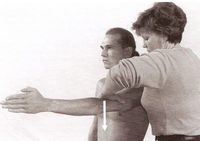 30th Nov 2015
30th Nov 2015
Manual Therapy Techniques: the Uses and Distinctions
“I need a massage”, or “I need my back cracked.” These are two of the most repeated phrases we hear in rehabilitation. While patients may be correct in their need for bodywork, it’s important they understand the different types of manual therapy techniques they may encounter, the differences between techniques and why some may be used for specific results, rather than others. For example, using a massage to treat back pain would address the muscles that may be at the cause of the pain, while a chiropractic adjustment also referred to as spinal manipulation uses a technique of applied force to restore or to enhance joint function in the low back. These two techniques are different approaches to the same problem, in this case back pain, and while they differ in how the body is manipulated the goal of resolving pain and inflammation is the same.

Example of Manual Therapy Techniques for the Shoulder
The Common Types of Manual Therapy Techniques
Physical therapists, Chiropractors and massage therapists use specific or a combination of techniques to address different types of pain and injuries. The 3 most commonly used manual therapy techniques are massage, adjustments (also called manipulations) and joint mobilizations. Let’s discuss their differences and possible applications in a therapeutic setting.
- Massage: Used by physical therapists, chiropractors and massage therapists; massage is a combination of techniques that knead the muscles and connective tissue of the body. Using various amounts of pressure and techniques to reduce muscle adhesions, such as cross-fiber friction or trigger point release, massage can be used to reduce pain, inflammation and promote relaxation.
- Adjustments/Manipulations: Chiropractors focuses on treating neuromuscular disorders using manual adjustments and manipulations of the spine. One of the most common chiropractic techniques is the High Velocity, Low Amplitude (HVLA) approach which uses a specific thrust designed to rotate, shear or move the spine into the desired articulation. When patients say they need their back “cracked” it is because sometimes during an adjustment the body will make a popping sound, which is caused by the release of gas bubbles that have formed in the joint.
- Joint Mobilizations: Whereas joint manipulations use high velocity thrusts, mobilizations do not. Joint mobilizations are passive and performed close to the joint surface itself. This technique is appropriate for injured, frozen or joints with limited range of motion and help reduce pain while increasing movement. Usually used by physical therapists, a mobilization has the practitioner applying force which mimics the gliding movement of the joint. Sometimes, the therapist will use static pressure for a specific amount of time in order to increase the range of motion.
Bodywork is an integral tool in rehabilitation. It works for a variety of diagnoses and injuries and with the variation in techniques can be used across most patient populations. For example, patients with sciatic pain and those suffering from Fibromyalgia will benefit from manual therapy; however because of the pain cycle experienced by patients with Fibromyalgia, the treatment approaches must be different. When seeking treatment for injuries or chronic pain, its important patients understand the distinctions between manual therapy techniques and know that their best course of action is to seek the help of rehabilitation professional.
For more information on Manual Muscle Testing Equipment and Physical Therapy News go to ProHealthcareProducts.com.





